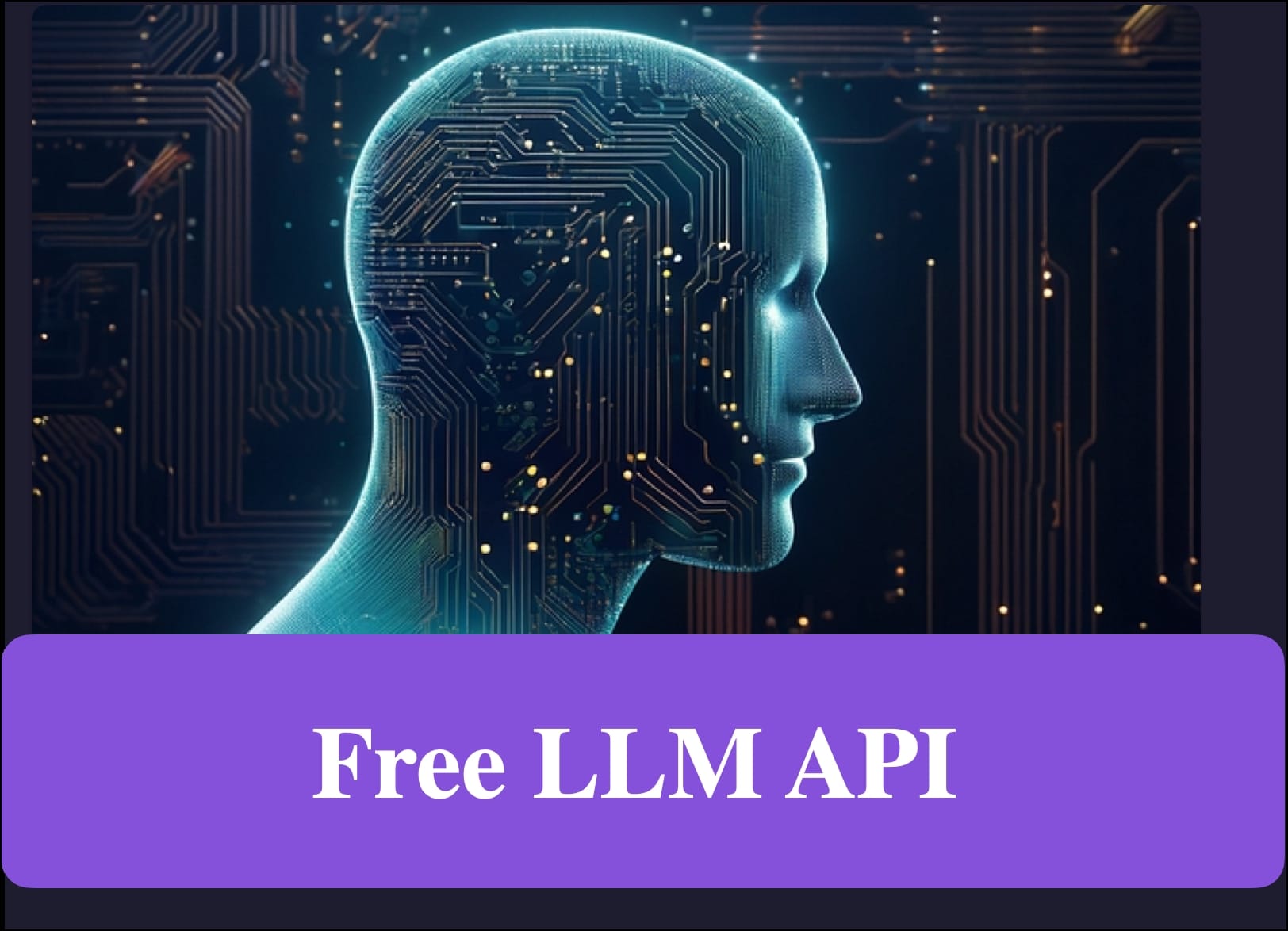Large Language Model API: Free Playground

Explore the top free LLM API tools and open models on our blog. Find all the resources you need for your next project.
Large Language Models (LLMs) have recently gained significant popularity in the field of Artificial Intelligence, and for good reason. They are capable of learning natural language processing tasks by training on large amounts of textual data. LLMs can be used for various applications such as chatbots, content creation, and even language translation. In this blog post, we will explore the top LLM APIs available in the market and the open-source LLM models that have gained traction among developers. We’ll also dive into real-world use cases of LLM APIs and provide guidance on how to choose the right LLM API based on your project requirements. Are you ready to unlock the potential of free LLM APIs? Let’s get started!
Understanding Large Language Models (LLMs)
Large language models, driven by neural networks, are transforming natural language processing. They play a pivotal role in sentiment analysis, speech recognition, and creative writing. GPT-3, among other LLMs, offers diverse applications in data science and programming. Acquiring a deep understanding of LLMs is indispensable for those venturing into the field of artificial intelligence. Incorporating generative AI, machine learning, and Python code, as well as leveraging models like Hugging Face’s Transformers, can cater to specific needs in various domains, from chat applications to blog content generation.
The Role of LLMs in Artificial Intelligence
The utilization of LLMs is vast, extending to text generation, language learning, and chatbot development. The open accessibility of these models facilitates language model training and research, enabling natural language conversations for chatbot interactions. Notably, LLMs like GPT greatly enhance human-AI interactions, shaping the future of NLP and AI advancements. These language models play a pivotal role in shaping the AI landscape and contributing to the evolution of natural language processing.
Key Features of LLMs
With advanced language processing capabilities, LLMs powered by neural networks offer various functionalities, including language translation, summarization, and sentiment analysis. These models excel in language understanding tasks with bidirectional encoder representations and support code generation, inference, and natural language conversations. Additionally, the language model parameters of LLMs optimize language learning and processing, catering to specific needs in diverse applications.

Exploring Top LLM APIs
Top LLM APIs, such as Jurassic-2, provide playgrounds for language models and enable developers to access API keys for language model inference. Google Bard’s LaMDA API supports natural language conversations and chatbot use cases, while Meta’s Llama2 API facilitates tutorials, analytics, and chatbot connectors. Additionally, OpenAI’s GPT API empowers creators with natural language generation. These APIs play a crucial role in advancing generative AI, language model tutorials, and natural language conversations, meeting specific needs in machine learning pathways.
AI21Labs: Jurassic-2
AI21Labs’ Jurassic-2 API enables language model inference and code generation, supporting diverse use cases for developers. With its language model playground, it aids in language learning and fosters research through open source access. Developers leverage Jurassic-2 for language model analytics, tutorials, and chatbot connectors, making it a versatile tool for specific needs in NLP, machine learning, and AI development. By empowering language model creators with pathways to language model exploration, Jurassic-2 stands out as a valuable addition to the NLP toolkit.

Anthropic: Claude 2
Anthropic’s Claude 2 API opens pathways for language model inference, supporting natural language conversations. It is widely utilized for language model analytics, tutorials, and chatbot connectors, empowering creators with specific needs. This generative AI tool fosters research and development in machine learning, leveraging diverse use cases. Claude 2 encourages exploration of language models through python code, enabling developers to experiment with chatGPT and audio processing. The API’s JSON interface facilitates easy integration with various platforms, from CPU-based systems to Vercel deployments.

Google Bard: LaMDA
Enabling natural language conversations and chatbot use cases, Google Bard’s LaMDA API empowers language model creators with diverse use cases. LaMDA, with open source accessibility, fosters language model research and tutorials, facilitating language model analytics, tutorials, and chatbot connectors. Developers leverage LaMDA for language model inference, analytics, and chatbot connectors, making it a pivotal tool in NLP applications. This API provides pathways for language model creators to address specific needs in various domains.

Meta: Llama2
Meta’s Llama2 API facilitates language model inference, analytics, and chatbot connectors. With a language model playground, Llama2 assists developers in language learning and supports diverse use cases for creators. This open-source access API fosters language model research and tutorials, empowering developers and creators to explore specific needs in machine learning. Developers can leverage Llama2 for language model analytics, tutorials, and chatbot connectors, making it a valuable addition to their toolset.

The Power of LLaMA 2
LLaMA 2, a versatile language model, is adept at facilitating natural language conversations. It provides open source pathways for various language model usages and exhibits significant applications in human language processing. The model’s design ensures it meets specific needs through generative AI, Python code, and machine learning. LLaMA 2’s capabilities make it a valuable addition to the NLP landscape, with potential uses in chat, audio, and email applications. Its accessibility encourages collaborative language model training and tutorials, furthering its impact in the NLP community.
OpenAI: GPT
Empowering language model creators with natural language generation, OpenAI’s GPT API provides a language model playground for developers to enhance language learning and code generation. With open source accessibility, it fosters language model research, tutorials, and chatbot connectors, supporting language model inference, analytics, and chatbot connectors for developers. The API is widely used for language model analytics, tutorials, and chatbot connectors, catering to specific needs in the pathways of language model development and deployment.

GPT-NeoX-20B: A Closer Look
Delving deeper into GPT-NeoX-20B, we find an advanced language model with 20 billion parameters, empowering extensive language capabilities. This model offers enhanced natural language processing, a result of the fusion between creative writing and artificial intelligence. Moreover, GPT-NeoX-20B presents a diverse array of language learning opportunities, catering to specific needs in various contexts. Its generative AI abilities and pathways language model make it a powerful tool for language-related tasks and projects, propelling it to the forefront of NLP innovation.
Real-World Use Cases of LLM APIs
LLM APIs have revolutionized content generation processes, enabling efficient language learning and text generation. These APIs also facilitate advanced language model inference, extending their use cases to creative writing and language model analytics. The impact of LLM APIs on natural language processing is significant, making them a valuable tool for various applications in NLP. From enhancing user interaction to assessing performance variations, LLM APIs cater to specific needs in diverse projects, showcasing the transformative power of generative AI.
LLM APIs in Content Generation
LLM APIs harness potent language model parameters for text creation, fostering enriched natural language interactions. These tools drive efficient content generation, elevating creative writing and language learning while bolstering AI development. Moreover, they extend to sentiment analysis and language model analytics, propelling advanced language processing capabilities. The impact of LLM APIs on user interaction and content creation is substantial, empowering diverse applications across generative AI, machine learning, and specific needs in language model inference.
Enhancing User Interaction with LLM APIs
Empowering user interactions, LLM APIs utilize language model parameters for speech recognition and language learning. These open pathways facilitate creative writing and AI. Their large language model capabilities drive user interaction enhancements, offering a wide range of possibilities for natural language processing applications.

Choosing the Right LLM API for Your Needs
Assessing LLM API performance variations is crucial for selection, involving language model analytics and text generation considerations. Evaluating the impact of LLM APIs on natural language processing is essential, aligning with specific language learning needs and extending to sentiment analysis and language model inference. The right LLM API should cater to these specific requirements, ensuring a seamless integration into projects and applications.
Assessing Performance Variations in LLM APIs
Performance assessments of LLM APIs involve language model analytics, crucial for evaluating text generation capabilities across LLM APIs. These assessments reveal the impact of LLM APIs on natural language processing, encompassing considerations for performance variations in language learning and artificial intelligence. This assessment process ensures efficient language model inference with LLM APIs. By considering specific needs and pathways language models, developers can make informed decisions regarding the selection of the most suitable LLM API for their projects.
Factors to Consider When Choosing an LLM API
Selecting an LLM API involves evaluating the language model analytics and essential factors like text generation capabilities. Scrutinizing the impact of LLM APIs on natural language processing is crucial, extending to considerations for sentiment analysis and language model inference. Aligning the right LLM API with specific language learning requirements is paramount. This selection process plays a vital role in ensuring that the chosen LLM API enhances language model inference and performance variations.

How Can Free LLM APIs Impact Your Project?
Free LLM APIs have a significant impact on projects. These APIs provide language model analytics without any cost, enabling text generation and natural language processing without financial constraints. They are valuable for language learning, AI projects, and contribute to open source language model pathways for creative writing.
What’s the Next Step in Incorporating LLM APIs in Your Project?
Enhancing natural language conversations and unlocking pathways for language learning and creative writing, incorporating LLM APIs in your project goes beyond just language model generation. However, it requires a good understanding of programming languages to integrate them effectively. Explore innovative chatbot functionalities with LLM APIs.
Conclusion
In conclusion, the availability of free LLM APIs has opened up a world of possibilities in the field of artificial intelligence. These large language models have revolutionized content generation and enhanced user interaction in various applications. Whether you’re looking for a versatile API like GPT-NeoX-20B or a powerful option like LLaMA 2, there are numerous choices available to suit your needs. When choosing an LLM API, it is important to assess performance variations and consider factors such as compatibility and support. By incorporating free LLM APIs into your project, you can leverage their capabilities to transform the way you create content and interact with users. Stay updated with the latest developments in LLM technology and take your project to new heights.
novita.ai provides Stable Diffusion API and hundreds of fast and cheapest AI image generation APIs for 10,000 models.🎯 Fastest generation in just 2s, Pay-As-You-Go, a minimum of $0.0015 for each standard image, you can add your own models and avoid GPU maintenance. Free to share open-source extensions.
Recommended reading